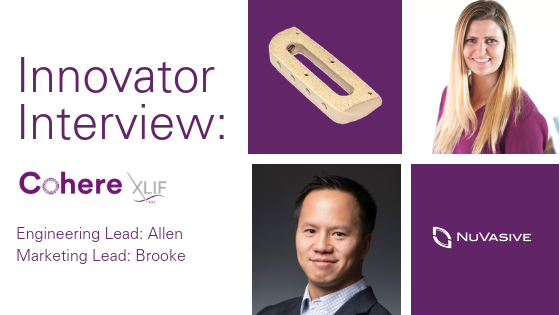We’re featuring Cohere® XLIF® innovators, Brooke and Allen, to give you an inside look into what it’s like helping drive innovation at NuVasive®.
Read their interview below:

What sparked the need for Cohere XLIF?
- Brooke, Marketing: Our proprietary Porous PEEK® technology is truly remarkable; it’s a groundbreaking innovation that Vertera Inc. pioneered and developed in 2013 in Atlanta, Georgia. This unique advancement in PEEK technology made Vertera a very attractive acquisition opportunity, and we are incredibly excited that they have joined the NUVA family! You’re taking a radiolucent material that traditionally did not integrate with bone, and changing the surface to make it possible to do just that. PEEK is a great surgical material that has been used for many years, but it has lacked porosity. What has been observed for years is a layer of fibrous tissue that encapsulates the smooth PEEK implant, and makes it virtually impossible for bony apposition to take place. With Cohere, we’ve addressed that problem, and now surgeons who appreciate the intrinsic qualities of PEEK, can continue to see those benefits, and add surface technology that allows the implant to participate in the fusion process.
- Allen, Engineering: On one hand, the XLIF procedure and implant has been the NuVasive flagship since the early days with documented clinical outcomes. On the other hand, the Cohere Porous PEEK portfolio provides an opportunity to improve implant integration strength with bone without compromising its desirable bulk mechanical strength and radiolucency. It’s a no-brainer to marry the two technologies in an aim to achieve even better patient outcomes.
What were the resources required to develop Cohere XLIF?
- Allen, Engineering: From a design standpoint, the CoRoent® XLIF implants provided a great starting point. With Brooke’s guidance and an engaged team of surgeon leaders, we made some modifications to the legacy design to become more aligned to the overall Advanced Materials Science™ (AMS) portfolio and to facilitate ease of manufacturing. From a manufacturing aspect, having launched a cervical and a posterior fusion implant featuring porous PEEK, the Atlanta team got a head start developing Cohere XLIF. However, the much larger sized XLIF implants challenged our understanding of the relatively new manufacturing process. The Mechanical Engineering and Prototyping teams ensured quick turnaround of ideas, parts, and materials to support continued learning and development.
Sometimes the first idea might not be the best idea. Was the original idea for Cohere XLIF what it is today? If it changed, what necessitated the change?
- Brooke: Similarly to the Modulus® XLIF implants, we didn’t want to simply take an existing design and just apply new technology to it. In working with our surgeon design team, we were able to discuss the opportunities for improvement from our legacy PEEK implant designs, and apply them to the design of Cohere XLIF. There were also other things to consider, such as tactical differences in insertion due to the surface changes, aperture size, and overall geometry. Overall, working with our surgeon partners to determine an optimized design was a fun and collaborative process, and I am thankful to have had the opportunity to work with such an outstanding internal development and surgeon team.
- Allen: The first lateral fusion implant idea was tabled by the original Porous PEEK design team, formerly Vertera Spine. The necessary surgical technique and instrumentation for a lateral procedure created a sizable hurdle for a small startup, so we opted to step in to the spine market with a smaller, simpler cervical implant to prove out the Porous PEEK platform. One year into the acquisition, with NuVasive XLIF knowledge, foundation, and success, we are on our way to commercializing Cohere XLIF.
What was your favorite part about the design and marketing process for Cohere XLIF?
- Brooke: I absolutely love the science behind this technology. It seems in the medical device marketplace, many companies are innovating simply to stimulate their revenue growth, without advancing a truly unique or innovative product. It’s been extremely exciting to develop and learn about a technology that is much differentiated, like nothing else on the market. As a spine patient myself, it’s incredible to know that Cohere will be empowering surgeons and influencing the lives of patients in a positive way.
- Allen: The excitement and anticipation for the Cohere XLIF implant and its potential impact to NuVasive, the spine industry, and ultimately patients’ lives are the biggest motivators.
What skills were needed to help create Cohere XLIF?
- Allen: As an engineer, getting familiarized with the XLIF surgical technique and working efficiently within a much larger company are probably the most critical and challenging skills I’ve had to learn. Technically, continuing to push the boundary of Porous PEEK is exciting and the team is gaining a deeper understanding of the technology on a daily basis.
What do you believe the benefits are of having a product offering like Cohere XLIF?
- Brooke: As seen in clinical and pre-clinical studies, surface porosity is what drives higher osteogenic response at the cellular level and translates into the greater integration strength when compared to traditional interbody implants. When the ultimate goal is fusion, stability within the fusion site is paramount. After the launch of Porous PEEK technology (Cohere) and porous metal technology (Modulus), surgeons will have the power to choose the implant material they believe is best for their practice and their patients. Empowering surgeons, and improving patient lives—that’s what this is ALL about.
View a few of our other Innovator Interviews: XLIF® Crestline™, Modulus® XLIF, Lateral ALIF™, and RELINE® Small Stature.
If you’re interested in becoming part of the innovation here at NUVA, search our open roles here.